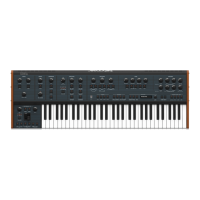11 UB-Xa User Manual
(75) Modulation Lever – the Modulation Lever is spring loaded and returns
to center when released. Pushing the lever up increases the amount of
modulation applied. This will be summed to any modulation being applied
by the Depth control and/or Footpedal. The action of the downward and
upward motion of the lever can also be individually used as a Modulation
Matrix source.
(76) OSC1 – applies LFO modulation, according to settings for Depth, Lever and
Footpedal to oscillator 1.
(77) OSC 2 – applies LFO modulation, according to settings for Depth, Lever and
Footpedal to oscillator 2.
When both buttons are pressed equal amounts of modulation are applied
to both oscillators. These controls are deactivated during Auto tuning to
ensure tuning accuracy.
(78) OSC 2 ONLY – applies pitchbend only to oscillator 2. When used in
conjunction with the Sync and F-Env controls described in the Oscillator
section very expressive timbral eects can be created. When the control is
not active pitchbend will be applied to both oscillators equally.
(79) AMOUNT – this control sets the range of the pitchbend lever. When
it is not applied (LED o) the lever will bend the pitch up or down by a
maximum of one whole note (EG ‘C’ up to ‘D’ or down to ‘Bb’). When it is
applied (LED on) the lever will bend through a selected range up or down.
To select the bend range hold the amount button and press any key on the
keyboard, then release the button. Default on power-up is one octave.
(80) TRANSPOSE DOWN – shifts the register of the keyboard down by one
octave on rst press (solid LED on) or two octaves on second press (LED
ashing). This can be reversed using Transpose Up (81), or by pressing both
buttons together.
(81) TRANSPOSE UP – shifts the register of the keyboard up one octave on rst
press (solid LED on) or two octaves on second press (LED ashing). This
can be reversed using Transpose Down (80), or by pressing both buttons
together.
If the LEDs in 80 and 81 are not lit then the keyboard is in its normal range.
If the Shift button (49) is active then transposition takes place in semitone
steps. Transposition also takes place when the UB-Xa is being controlled by
an external MIDI source
Shift Functions
Many of the UB-Xa’s controls, both rotary and button, have second functions,
mostly indicated in grey type below the main legend in white. These are
described below, except for those associated with the sequencer, which were
discussed in the sequencer section.
Shift & 6 (Portamento Control) – Porta Glide – if Porta Glide is switched
on in the Velocity and Aftertouch menu then holding Shift and adjusting the
Portamento control will adjust the glide rate from -32 to +31.
Shift & 7 (Unison) – Poly Modes – switches between Poly (default) where
between 1 and 8 voices can be selected (default is 2) and Unison where between
1 and 16 voices can be selected (default is 1).
Shift & 8 (Osc 2 Detune) – Voice Detune – allows the individual voices to be
detuned, upwards only, from each other, with a dead band between 0 and 25 and
a maximum setting of 255. This function is particularly eective in Unison mode.
Shift & 13 (LFO Rate) – LFO Sync – holding the Shift button and turning the
LFO rate control syncs the LFO to whatever clock is being used by the sequencer
and arpeggiator. The options are:
• 4 Bar
• 2 Bar
• 1 Bar
• ½ Note
• ¼ Note
• Dotted ¼ Note
• ¼ Note Triplet
• 1/8 Note
• Dotted 1/8 Note
• 1/8 Note Triplet
• 1/16 Note
• Dotted 1/16 Note
• 1/16 Note Triplet
• 1/32 Note
• Dotted 1/32 Note
• 1/32 Note Triplet
Moving the rate control without shifting returns the LFO to free running.
Shift & 16 – Quantize 1 – quantizes the LFO waveform when applied to the
rst modulation channel (Frequency).
Shift & 20 – Quantize 2 – quantizes the LFO waveform when applied to the
second modulation channel (Pulse Width).
Shift & 17 – Invert 1 – inverts the modulation envelope for mod channel 1.
Shift & 21 – Invert 2 – inverts the modulation envelope for mod channel 2.
Shift & 18 – LFO Track – increases or decreases the speed that the LFO is
running at in relation to the most recent key pressed – the higher the note the
faster the LFO will run. This function does not disable the rate control, but works
in conjunction with it.
Shift & 22 – LFO Env Mod – allows the lter envelope to modulate the LFO
depth.
Shift & 24 – LFO Phase 90˚ - changes the phase of the LFO to 90˚out from its
normal phase.
Shift & 25 – LFO Phase 180˚- changes the phase of the LFO to 180˚out from its
normal phase.
Pressing Shift and buttons 24 & 25 changes the phase of the LFO to 270˚out from
its normal phase.
Shift & 27 – OSC1 LFO Invert Freq – inverts the LFO frequency modulation to
oscillator 1 only.
Shift & 28 – OSC1 LFO Invert PW – inverts the LFO Pulse Width Modulation to
oscillator 1 only.
Shift & 41 – Mod 1 Delay – delays the introduction of frequency modulation to
modulation channel 1.
Shift & 42 – Mod 1 Attack – applies an attack envelope to the depth of
modulation to modulation channel 1.
Shift & 44 – LFO Trigger Point – controls the trigger point of the LFO
waveform, from no trigger to full wave cycle, as illustrated below:
(49)

